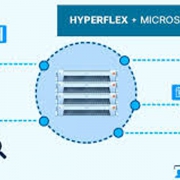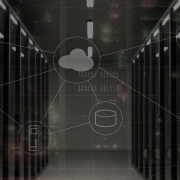The Challenge
The digital business transformation is upon us, and it is creating new demands on IT organizations:
- Applications: Modern applications are becoming less monolithic and more like organic entities that grow and shrink through the use of modular, distributed microservices. This reduces dependence on traditional IT infrastructure and places new demands on IT organizations in terms of the large number of endpoints to manage and flexible infrastructure needed to support them. With agile development and DevOps deployment approaches becoming the norm, developers and administrators demand the capability to program their own infrastructure. This is necessary in order to quickly roll out new applications and updates to existing ones.
- Management: The main issue for IT organizations is managing infrastructure at scale and being able to match resources to application requirements—yet manage all of the different types of infrastructure in a simple, holistic fashion. Furthermore, the IT organization’s clients—line-of-business managers, application developers, and DevOps teams—are asserting increasing influence over the adoption, purchase, and deployment of technology. IT organizations saddled with ponderous management tools are hard pressed to compete with the fluidity of self-service, multicloud environments that their clients can purchase on their own if the IT organization doesn’t keep pace.
- Location: Once upon a time traditional IT organizations could support and manage their clients and applications safely within the glass walls of an on-premises data center. Now they must support clients, applications, and workloads in public, managed, edge, and private cloud environments— all while maintaining compliance with best practices, business and governmental regulations, and data sovereignty requirements.
As a modern IT organization, the challenge is to meet the needs of the digital business transformation while still supporting the traditional, monolithic applications that are the foundation of your business. You have to simultaneously embrace the traditional deployment model and the fluid nature of today’s multicloud deployments.
The Solution
The straightforward solution to today’s data center challenges is Cisco Unified Computing System™ (Cisco UCS®). It’s not a collection of servers. It’s a fully self-aware, self-integrating system. Because it is 100 percent programmable, it has been the solution to computing challenges for more than 63,000 customers since 2009. The system is flexible, agile, and adaptable, and the portfolio of products supported by Cisco UCS includes blade, rack, multinode, and storage-intensive servers; converged infrastructure; hyperconverged infrastructure (Cisco HyperFlex™ systems); and solutions for the network edge such as Cisco UCS Mini and Cisco HyperFlex Edge.
There is a fundamental difference between vendors that sell servers and Cisco Unified Computing System. Servers arose as more powerful personal computers, taking many of their attributes, including time consuming, manual, error-prone configuration of I/O, network, and storage subsystems. Traditional servers are monolithic, complex to deploy, and even more complex to adapt to new workload demands. In contrast, Cisco UCS is a single unified system, with six fundamental attributes that make it revolutionary.
Fabric Centric
We blend all of the system’s I/O traffic into a single shared active-active network that carries all modes of communication from servers to the outside world. Our low-latency, high-bandwidth network fabric is a shared resource so networking can be allocated to interfaces based on policies rather than physical interface configuration and hard-wired cabling. The result is that you can provision and balance resources to meet your workload needs easily.
Endpoint Aware
Cisco UCS was developed in the virtualization era, where the norm was multiple independent workloads running on the same server. Today the number of workloads has become practically unimaginable as containerized environments place hundreds of workloads in a single virtual machine. Whether you run virtualized, containerized, or bare-metal workloads, all I/O is virtualized. This gives you the capability to support a massive number of endpoints but with a level of control equivalent to each endpoint having its own dedicated (but virtual) cable to the outside world. This gives you the scale of virtualized, with the workload isolation and security of the physical world.
100 Percent Programmable
From the very beginning, Cisco UCS was designed with the entire state of each server—identity, configuration, and connectivity—abstracted into software. This makes our system 100 percent programmable, easy to adapt to the varying requirements of both modern workloads and traditional monolithic business applications. With a completely programmable system, you can give your clients the level of control they need to manage their workloads. For global organizations, Cisco Intersight™ software-as-a-service management gives you complete role- and policy-based control over all of your resources regardless of where they reside. Fine-grained infrastructure management can be handled in Agile development and DevOps shops with scripting languages that provide access to the Cisco UCS unified API.
Intent Based
Cisco Intersight software helps you to more precisely align your infrastructure with the needs of your business. It enables administrators to automate configurations or tasks based on specific requirements that are tied to business objectives and application performance. Rather than having to be concerned with every detail of system configuration, intent-based management enables you to describe what you want to accomplish, with the cloud-based automation we provide translating your intent into action.
Delivers Business Benefits
Our policy-based approach to management gives you the simplicity, automation, and capabilities you need to increase productivity and support a fast-paced business environment.
- Improved staff productivity: By aligning your infrastructure with applications and the way teams work together, you can create synergies that can’t be achieved with other architectures.
- Better use of IT staff: The common, simplified management of servers, storage, and fabric establishes best practices and eliminates the need to understand the nuances of specific components. You can use your subject matter experts to develop policies and use lower-level administrators or operations personnel to implement policies.
- Effective communication: Cisco UCS management improves communication between roles through cross-visibility and role-based administrative access.
- Faster time to value: You can rapidly roll out new applications and business services at cloud-like speed and enhance the competitive strength of your enterprise.
- Increased operational efficiency: You can automate many routine tasks, improve resource utilization, and proactively prevent manual errors that typically keep your IT staff from working on high-value tasks.
- Improved flexibility and agility: The capability to automatically integrate additional resource capacity into larger, flexible pools helps ensure that your IT staff can achieve economies of scale and efficiency without greater complexity.
Analytics Powered
What if your infrastructure integrated directly with your support organization? The recommendation engine built into Cisco Intersight software integrates with the Cisco® Technical Assistance Center (TAC) to help you easily detect problems and initiate support requests. As the Cisco Intersight recommendation engine gains intelligence, our vision is for it to provide suggestions and recommendations for you to optimize your configurations to gain the most from your investment.
Download the full UCS Solution Overview from Cisco.
Located near the booming data center corridor in Loudon County, VA, Digital Tech Inc provides rapid response maintenance services including EOSL extension, spare parts, short- and long-term maintenance agreements, migration assistance and depot repair options. Our skilled engineers offer multi-vendor support, covering IBM, HP, Dell EMC, Cisco, NetApp, and many more.
To learn more, contact us today.











